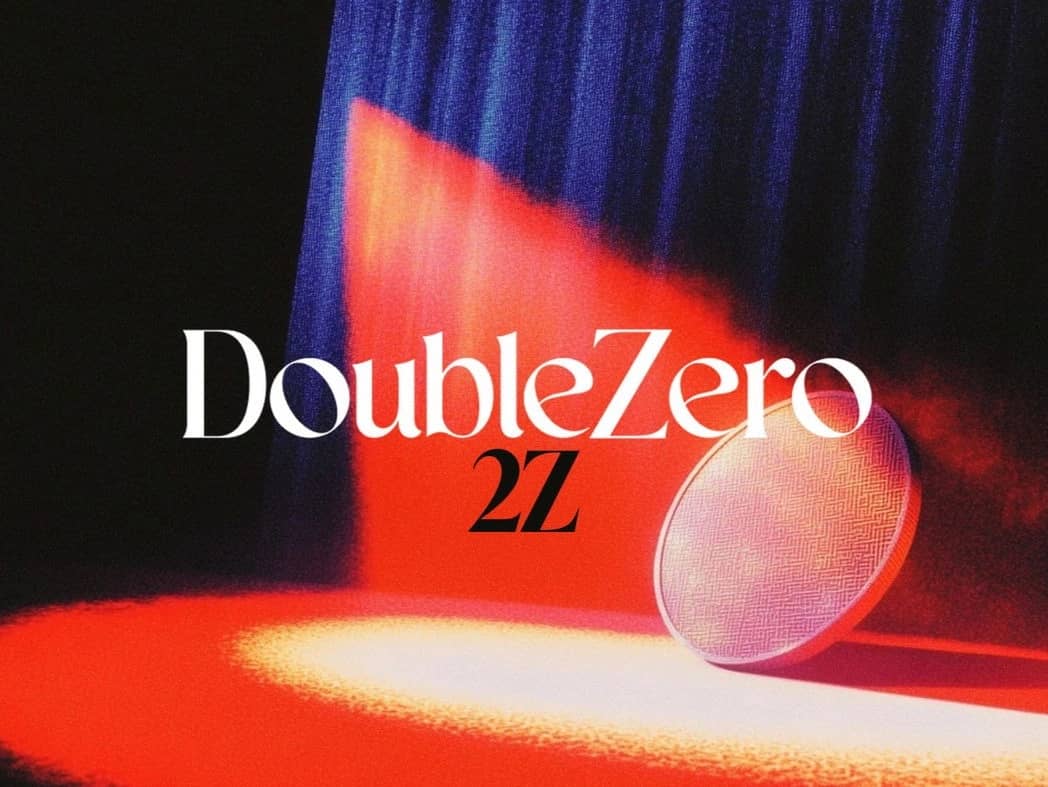订阅 wiki
Share wiki
Bookmark
DoubleZero
DoubleZero
DoubleZero 是一个去中心化的物理基础设施网络 (DePIN),它提供了一个由专用光纤链路组成的高性能、低延迟的全球网络。该协议旨在通过创建一个绕过公共互联网拥塞的专用传输层来加速区块链和其他分布式系统的通信。
概述
DoubleZero 的开发是为了解决公共互联网在时间敏感、高吞吐量应用(如区块链共识)方面的固有局限性。该项目的创始人发现,为通用用途而设计的公共互联网,成为了数千个分布式节点所需的实时协调的瓶颈。标准互联网基础设施上的高延迟、抖动和数据包丢失会对区块链安全性、验证者性能和整体用户体验产生负面影响。该协议旨在通过创建一个代币激励的、无需许可的带宽市场来解决这个问题,该市场充当关键网络流量的“快车道”。[1] [2]
该网络建立在独立供应商贡献的未充分利用或“黑暗”的私有光纤链路上。这些贡献者因提供高质量、可靠的带宽而获得网络的原生实用代币 2Z。 区块链验证者或 RPC 节点运营商等用户使用 2Z 代币来支付访问这些优化的直接路由路径的费用。这种模式创建了一个加密经济系统,鼓励强大的物理基础设施层的增长。 DoubleZero 将自己定位为一个基础性的“N1”或物理网络基础设施层,其他依赖网络的应用程序和服务可以在此基础上构建。该项目由 DoubleZero 基金会管理,该基金会支持网络的开发、去中心化和采用。[3] [4]
历史
DoubleZero协议的基本概念在2024年12月2日发布的白皮书中详细说明,该白皮书由Austin Federa、Andrew McConnell和Mateo Ward共同撰写。该项目于2025年初开始开发阶段,第一季度在全球七个地点启动了许可测试网,第二季度启动了公共测试网。2025年3月,该项目在一轮由Dragonfly和Multicoin Capital领投的融资中获得了2800万美元,公司估值为4亿美元。2025年4月,向网络验证者进行了原生2Z 实用代币的封闭式销售。 [3] [5] [1] [2]
2025年9月29日,美国证券交易委员会(SEC)向DoubleZero发布了一封不采取行动函,这是一个重要的里程碑。这为其DePIN模式提供了监管方面的明确性,确认向网络贡献者分发2Z代币以换取服务无需进行证券注册。此后,DoubleZero 主网-beta于2025年10月2日正式上线。启动时,该网络包含70多个直接高速链路,连接25个地理位置,并已接纳代表Solana网络上所有已质押SOL的22%的验证者。2Z代币的公开首次亮相与主网启动同时进行。不久之后,2025年10月5日,联合创始人Austin Federa公开确认DoubleZero基金会没有出售任何代币持有量,此声明旨在解决社区对发布后潜在市场影响的担忧。 [2] [6]
技术
DoubleZero的架构旨在通过将关键区块链流量与公共互联网分离,来创建一个高性能的去中心化网络。它利用概念性的“同心环模型”来管理数据流和安全性。 [3]
网络架构
该网络架构分为两个主要层级:
- 外环(入口/出口): 这一层作为与公共互联网的接口。它采用专用硬件,例如现场可编程门阵列(FPGA),来执行边缘过滤。此过程包括缓解DDoS攻击、验证交易签名以及在垃圾邮件或重复交易进入核心网络之前将其删除,从而减轻单个验证者的计算负担。
- 内环(数据流): 这是核心传输层,由专用、优化路由的私有光纤链路网格构成。它专为网络节点之间的高速、低延迟通信而设计,并支持高效的数据传播方法,例如多播。
该架构由几个关键组件支持。光纤链路由承诺服务水平协议(SLA)的提供商以无需许可的方式贡献,该协议编码在智能合约中,定义了带宽、延迟和正常运行时间等指标。网络设备使这些不同的链路能够作为一个有凝聚力的网络运行,并执行高级过滤功能。DoubleZero交换点(DZXs)充当核心互连枢纽,类似于公共互联网交换中心,以促进全球网络中的高效数据传输。整个系统由智能合约定义的控制平面管理,这是一个公共区块链上的分布式系统,它使用链上数据来动态管理网络配置、路由和定价。 [3] [7]
主要特性
该协议包含多项功能,旨在增强分布式系统的性能和可靠性:
- 边缘过滤: 通过将流量验证和垃圾邮件防护卸载到网络边缘,DoubleZero 允许验证者将更多资源用于核心共识任务。
- 多播支持: 内环针对多播流量进行了优化,能够高效地将数据(如新区块或状态转换)进行一对多分发,这对于快速同步大量节点至关重要。
- 直接路由: 该网络绕过公共互联网的多跳、通常不可预测的路径,而是沿着两点之间最直接的物理路径路由数据,从而显著降低延迟。
- 密码经济激励: 该协议使用基于代币的奖励和惩罚系统,以确保带宽贡献者遵守其 SLA。该模型旨在维持高水平的网络性能和可靠性。
- 可验证路由: 该协议旨在提供数据包通过网络所采取路径的密码学证明,从而提高透明度并帮助解决与数据审查或操纵相关的问题。
这些功能旨在为下一代去中心化应用创建一个更高性能、更安全和更可靠的通信层。 [8] [7]
2Z 代币经济学
DoubleZero 网络由其原生实用代币 2Z 驱动。该代币是网络经济模型不可或缺的一部分,促进支付、激励和安全。2Z 代币最初在 Solana 区块链上作为 SPL 代币推出。 [9]
供应和分配
2Z代币的最大和总供应量为10,000,000,000个代币。DoubleZero基金会持有部分供应量,并将其作为激励措施分配给网络贡献者,用于运营活动,而不是在公开市场上出售。该项目的创始人、开发团队和早期风险资本投资者均受代币锁定协议的约束,以使其长期利益与网络的增长保持一致。 [5] [6]
代币效用
2Z代币在DoubleZero生态系统中具有四个主要功能:
- 访问资源: 验证者和dApp开发者等用户支付2Z代币以消耗网络资源并访问其高速连接服务。该协议还支持以受支持区块链的原生代币(例如,SOL)进行支付,这些代币随后在后端转换为2Z。
- 贡献者支付: 提供光纤链路、硬件和其他服务的网络贡献者将获得2Z代币奖励。支付基于他们提供的资源的性能、可靠性和使用情况。
- 参与质押: 为了确保承诺和网络安全,贡献者和资源提供者需要质押2Z代币,才能向网络提供其链路和服务。
- 委托: 不直接贡献资源的代币持有者可以将他们的2Z代币委托给资源提供者。这使他们能够参与网络的安全和激励机制,并赚取一部分奖励。
这种经济模型旨在创建一个自我维持的循环,其中对网络服务的需求驱动代币的价值,进而激励物理基础设施的扩展和改进。 [9] [5]
使用案例
DoubleZero旨在为各种需要高性能、低延迟通信的应用提供基础架构层,无论是在区块链生态系统内外。 [3]
区块链应用
DoubleZero的主要市场是区块链行业,网络性能对于安全性和可扩展性至关重要。
- Layer 1 区块链: 该网络通过减少区块传播时间来帮助加速共识,并允许验证器通过卸载资源密集型任务(如交易过滤)来更有效地运行。
- Layer 2 区块链: 对于Layer 2解决方案,DoubleZero可以加快将数据发布到Layer 1链的过程,促进多个排序器之间的协调,并为数据可用性层提供高带宽连接。
- RPC节点和预言机: RPC提供商可以使用该网络进行DDoS保护,并确保低延迟的交易转发。实时预言机可以从更快地向区块链发送和接收数据中受益。
- 最大可提取价值 (MEV): MEV系统可以利用该网络更快地访问网络状态(读取操作)并更快地向验证器交付区块和捆绑包(写入操作),从而提高效率。
非区块链应用
该协议的能力扩展到传统的高性能计算和通信领域。
- 内容分发网络(CDN): 该网络提供灵活的按需带宽来源,允许新的CDN启动其基础设施,或允许现有的CDN在没有长期租赁的情况下增加其容量。
- 在线游戏: DoubleZero可以减少点对点和中央服务器游戏架构的延迟和抖动,从而带来更流畅的用户体验。
- 分布式AI/LLM训练: 该网络可以为地理上分布的数据中心之间提供所需的高带宽、低延迟连接,从而更有效地训练大型语言模型。
- 企业网络: 该协议为传统的专用网络租赁提供了一种无需许可且灵活的替代方案,使企业能够根据实时需求动态调整其带宽和路由。
这些用例突出了该协议创建一种新的、更高效的互联网骨干网的目标,该骨干网针对分布式系统进行了优化。 [3]
生态系统和团队
DoubleZero生态系统由其创始团队、战略投资者、基础设施贡献者和早期采用者组成。该项目由Austin Federa联合创立,他之前曾在Solana 基金会工作。该项目的白皮书也由Malbec Labs的 Andrew McConnell 和 Mateo Ward 共同撰写,Malbec Labs是网络开发中的关键技术合作伙伴。 [2] [3]
该项目得到了著名风险投资公司的支持,Dragonfly 和 Multicoin Capital 在2025年3月领投了2800万美元的融资。物理网络建立在由独立带宽贡献者组成的联盟提供的基础设施之上,包括 Jump Crypto、Galaxy、RockawayX 和 Staking Facilities 等主要行业参与者。该网络的早期采用者和用户包括区块链领域的一些主要验证者,如 Coinbase、Figment 和 Everstake。该项目最初非常关注Solana生态系统,Solana联合创始人Anatoly Yakovenko认可了该网络对Solana高性能目标的贡献。 [1] [8]
"Solana一直以同步世界信息为使命,而DoubleZero的光纤网络使这一愿景更接近现实。高性能基础设施驱动的互联网资本市场是Solana与传统市场竞争的方式,而DoubleZero正在为这一愿景做出有意义的贡献。" — Anatoly Yakovenko,Solana联合创始人 [8]
法律和监管状态
DoubleZero于2025年9月29日获得美国证券交易委员会(SEC)的不采取行动函,这是一个重要的监管里程碑。该函澄清了该项目的代币分配模式,确认向网络贡献者提供2Z代币作为工作报酬(例如共享带宽或运行节点)不构成证券发行,因此不需要根据美国证券法进行注册。 [2]
该决定被视为更广泛的 DePIN 领域的里程碑,为其他具有类似代币激励基础设施模型的项目提供了潜在的法律框架。SEC委员海丝特·皮尔斯在一份与该决定相关的声明中阐述了这一区别,认为此类代币的功能是为提供的服务付款,而不是作为一种投资,期望从他人的努力中获利。这种监管清晰度是该项目 主网 启动和公开代币首次亮相的关键先决条件。 [6]
“运行节点、提供存储或共享带宽的人会获得奖励。这些代币既不是公司的股票,也不是承诺从他人管理努力中获利的承诺。” — 海丝特·皮尔斯,SEC委员 [2]
争议
在2025年10月初2Z代币公开发布后,社区对DoubleZero基金会出售其大量代币持有量的可能性表示担忧,这可能会对代币的市场价格产生负面影响。发布后最初的价格波动加剧了这些担忧,至少有一份报告指出价格下跌导致了对“[[代币经济学](https://iq.wiki/wiki/tokenomics)]”的强烈反对。为了回应这种猜测,联合创始人奥斯汀·费德拉于2025年10月5日发表公开声明,确认该基金会没有出售任何代币,并重申其持有的代币指定用于长期网络开发和贡献者激励,而不是用于短期财务收益。 [6] [5]
发现错误了吗?
